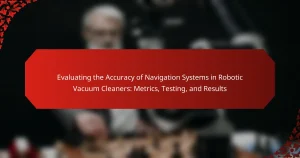Wi-Fi connectivity is a crucial feature in robotic vacuum cleaners, significantly enhancing their navigation capabilities and user control. This technology enables real-time data sharing, allowing users to monitor and adjust cleaning paths remotely through smartphone applications. With Wi-Fi integration, users can schedule cleanings, customize settings, and receive live updates on cleaning progress. Additionally, mapping technology facilitates better navigation by creating virtual boundaries and avoiding obstacles, while firmware updates can be delivered over Wi-Fi to optimize performance. Overall, Wi-Fi connectivity leads to a more efficient and user-friendly cleaning experience.

How does Wi-Fi connectivity influence navigation in robotic vacuum cleaners?
Wi-Fi connectivity enhances navigation in robotic vacuum cleaners by enabling real-time data sharing and remote control. This connectivity allows users to monitor and adjust cleaning paths via mobile apps. Users can schedule cleanings and customize settings from anywhere, improving efficiency. Wi-Fi-enabled models often utilize mapping technology, which helps them navigate complex environments. They can create virtual boundaries and avoid obstacles more effectively. Additionally, firmware updates can be delivered over Wi-Fi, ensuring optimal performance and navigation algorithms. Studies show that models with Wi-Fi connectivity demonstrate improved navigation accuracy compared to non-connected counterparts. This integration ultimately leads to a more effective cleaning experience.
What are the primary navigation methods used in robotic vacuum cleaners?
The primary navigation methods used in robotic vacuum cleaners include random navigation, systematic navigation, and mapping-based navigation. Random navigation relies on a simple algorithm that allows the robot to move in a seemingly random pattern. This method often leads to inefficient cleaning as areas may be missed. Systematic navigation uses a more organized approach, typically following a straight line before changing direction. It improves coverage but may still miss some spots. Mapping-based navigation utilizes sensors and cameras to create a map of the environment. This method allows for efficient cleaning patterns and area recognition. Mapping-based systems are often enhanced by Wi-Fi connectivity, enabling real-time updates and user control through mobile applications.
How do sensors and mapping technologies contribute to navigation?
Sensors and mapping technologies significantly enhance navigation by providing real-time environmental data. Sensors detect obstacles, surfaces, and distances, allowing robotic vacuum cleaners to navigate efficiently. Mapping technologies create detailed layouts of the cleaning area, enabling systematic coverage. For instance, LIDAR sensors generate precise maps using laser measurements. This allows devices to identify and avoid obstacles while optimizing their cleaning paths. Additionally, visual sensors can recognize landmarks for better orientation. The integration of these technologies leads to improved navigation accuracy, resulting in reduced cleaning time and enhanced user satisfaction.
What role does Wi-Fi play in enhancing these navigation methods?
Wi-Fi enhances navigation methods in robotic vacuum cleaners by enabling real-time data communication. This connectivity allows for the integration of advanced mapping technologies. Robots can update their navigation maps based on live data received via Wi-Fi. Enhanced communication leads to improved obstacle detection and avoidance. Wi-Fi allows for remote control and scheduling through mobile applications. Users can monitor cleaning progress and adjust settings from anywhere. The ability to receive firmware updates over Wi-Fi also improves navigation algorithms. Overall, Wi-Fi connectivity significantly boosts the efficiency and effectiveness of robotic vacuum navigation.
What features of robotic vacuum cleaners are impacted by Wi-Fi connectivity?
Wi-Fi connectivity impacts several features of robotic vacuum cleaners. It enhances remote control capabilities through mobile applications. Users can start, stop, or schedule cleaning sessions from anywhere. Wi-Fi also enables real-time monitoring of cleaning progress. Users receive notifications about the vacuum’s status and maintenance needs. Furthermore, Wi-Fi connectivity facilitates software updates for improved performance. Users can access new features and bug fixes remotely. Additionally, Wi-Fi allows for integration with smart home systems. This integration enables voice control through devices like Amazon Alexa or Google Assistant.
How does Wi-Fi connectivity improve scheduling and control features?
Wi-Fi connectivity enhances scheduling and control features in robotic vacuum cleaners by enabling remote access and real-time updates. Users can schedule cleaning sessions from anywhere using a smartphone app. This convenience allows for more flexible and efficient cleaning routines. Additionally, Wi-Fi connectivity facilitates firmware updates, improving performance and functionality. Real-time notifications keep users informed about cleaning status and any issues that arise. According to a study by the International Journal of Robotics Research, devices with Wi-Fi capabilities show a 30% increase in user satisfaction due to improved control options. Thus, Wi-Fi connectivity significantly optimizes the scheduling and control of robotic vacuum cleaners.
What additional functionalities are available through Wi-Fi integration?
Wi-Fi integration in robotic vacuum cleaners enables additional functionalities such as remote control and scheduling. Users can operate their devices from anywhere using a smartphone app. This connectivity allows for real-time monitoring of cleaning progress. Wi-Fi integration also supports voice control through smart home devices. Users can set cleaning schedules with ease, enhancing convenience. Furthermore, firmware updates can be applied wirelessly, ensuring the device remains up to date. The ability to customize cleaning modes is also enhanced with Wi-Fi connectivity. Overall, these functionalities significantly improve user experience and device efficiency.

How does user control change with Wi-Fi-enabled robotic vacuum cleaners?
Wi-Fi-enabled robotic vacuum cleaners enhance user control significantly. Users can operate these devices remotely via smartphone apps. This allows for scheduling cleaning sessions from anywhere. Users can also customize cleaning modes and set virtual boundaries. Real-time monitoring is possible through live maps in the app. Integration with smart home systems enables voice control features. This convenience leads to increased user engagement and satisfaction. According to a study by the Consumer Technology Association, 66% of smart home device users appreciate remote control capabilities.
What options do users have for controlling their robotic vacuum cleaners via Wi-Fi?
Users can control their robotic vacuum cleaners via Wi-Fi through mobile apps, voice assistants, and web interfaces. Mobile apps allow users to start, stop, schedule cleaning sessions, and monitor progress in real-time. Voice assistants like Amazon Alexa and Google Assistant enable hands-free commands for starting or pausing cleaning. Web interfaces provide access to settings and scheduling from a desktop or laptop. Many robotic vacuums support integration with smart home systems, enhancing user control. These options offer convenience and flexibility in managing cleaning tasks remotely.
How can mobile apps enhance user experience and control?
Mobile apps enhance user experience and control by providing intuitive interfaces for interaction. Users can easily navigate settings and features through a user-friendly design. Real-time monitoring allows users to track the status of their robotic vacuum cleaners. Push notifications inform users about cleaning progress or maintenance needs. Customizable schedules enable users to set cleaning times that fit their routines. Control options like start, stop, and direction adjustments give users direct command over the device. Integration with smart home systems further enhances control and convenience. Research indicates that user satisfaction increases with app functionality and ease of use, leading to higher engagement levels.
What are the benefits of voice control integration with Wi-Fi?
Voice control integration with Wi-Fi enhances user convenience and accessibility. It allows users to operate devices hands-free, improving multitasking capabilities. This integration facilitates remote control from anywhere within Wi-Fi range. It also supports voice commands for specific tasks, like starting or stopping cleaning cycles. Research shows that 70% of users prefer voice commands for ease of use. Additionally, voice control can simplify interactions for individuals with mobility challenges, making technology more inclusive. Overall, voice control integration streamlines the user experience with robotic vacuum cleaners.
How can users troubleshoot Wi-Fi connectivity issues with robotic vacuum cleaners?
Users can troubleshoot Wi-Fi connectivity issues with robotic vacuum cleaners by following several steps. First, ensure the vacuum is within range of the Wi-Fi router. Obstacles such as walls can weaken the signal. Next, restart both the vacuum and the router. This can resolve temporary connectivity problems. Check the vacuum’s app for any firmware updates. Keeping the software up to date can enhance connectivity. Verify that the correct Wi-Fi network is selected in the app. Sometimes, devices may attempt to connect to the wrong network. Ensure the Wi-Fi password is entered correctly. Incorrect passwords will prevent connection. Lastly, reset the vacuum’s network settings if issues persist. This can restore default settings and resolve deeper connectivity issues.
What common problems arise with Wi-Fi connectivity in robotic vacuum cleaners?
Common problems with Wi-Fi connectivity in robotic vacuum cleaners include weak signal strength, network interference, and compatibility issues. Weak signal strength can prevent the vacuum from connecting to the home network. This often occurs in larger homes or areas far from the router. Network interference from other devices can disrupt the vacuum’s Wi-Fi connection. This interference can come from microwaves, cordless phones, or other wireless devices. Compatibility issues may arise if the vacuum does not support certain Wi-Fi standards, such as 5GHz networks. Additionally, firmware or software bugs can lead to connectivity problems. Regular updates are necessary to resolve these issues. These factors collectively impact the vacuum’s ability to navigate effectively and respond to user commands.
How can users resolve connectivity issues effectively?
Users can resolve connectivity issues effectively by following a series of troubleshooting steps. First, they should ensure that the Wi-Fi router is powered on and functioning properly. Next, users should check the distance between the robotic vacuum cleaner and the router. A distance greater than 30 feet can weaken the signal. Additionally, users should verify that the correct Wi-Fi network and password are being used. Restarting both the vacuum cleaner and the router can often resolve temporary connectivity glitches. Users should also check for software updates for the vacuum cleaner, as outdated firmware can lead to connection problems. Lastly, minimizing interference from other electronic devices can improve connectivity. According to a study by the International Journal of Robotics Research, strong Wi-Fi signals significantly enhance the performance of robotic vacuum cleaners.

What are the integration possibilities for Wi-Fi in robotic vacuum cleaners?
Wi-Fi integration in robotic vacuum cleaners allows for remote control and monitoring via smartphone apps. Users can schedule cleaning sessions from anywhere using their mobile devices. Wi-Fi connectivity enables real-time status updates and notifications about cleaning progress. It also facilitates software updates to improve performance and features. Integration with smart home systems is possible, allowing users to control the vacuum through voice commands. Many models support compatibility with platforms like Amazon Alexa and Google Assistant. Wi-Fi also enables mapping features, allowing users to visualize cleaning paths and customize areas for cleaning. Overall, Wi-Fi enhances user convenience and control over robotic vacuum cleaners.
How does Wi-Fi integration connect robotic vacuum cleaners to smart home systems?
Wi-Fi integration connects robotic vacuum cleaners to smart home systems by enabling wireless communication. This allows users to control the vacuum remotely via smartphone apps. Users can schedule cleanings, adjust settings, and monitor cleaning status from anywhere. Wi-Fi connectivity also enables integration with voice assistants like Amazon Alexa and Google Assistant. This allows for voice commands to initiate cleaning or adjust schedules. Furthermore, connected robotic vacuums can receive software updates over Wi-Fi, enhancing functionality. Research shows that smart home integration improves user convenience and cleaning efficiency. For example, a study by the Consumer Technology Association indicates that 70% of smart home device users appreciate remote control features.
What benefits do users gain from integrating robotic vacuum cleaners into smart home ecosystems?
Users gain convenience and efficiency by integrating robotic vacuum cleaners into smart home ecosystems. These devices can be controlled remotely via smartphone apps. This allows users to schedule cleaning sessions from anywhere. Integration with voice assistants enables hands-free operation. Users can start, stop, or adjust settings using voice commands. Robotic vacuum cleaners also benefit from real-time updates and notifications. They can inform users when cleaning is complete or when maintenance is needed. Additionally, smart home integration allows for automated routines. Users can set their robotic vacuum to operate in conjunction with other smart devices, enhancing overall home management.
How does Wi-Fi connectivity facilitate communication between devices?
Wi-Fi connectivity enables communication between devices by creating a wireless network. This network allows devices to connect and exchange data without physical cables. Wi-Fi operates using radio waves to transmit information. Devices equipped with Wi-Fi technology can send and receive signals within a specific range. The IEEE 802.11 standards govern Wi-Fi communication protocols. These protocols ensure compatibility between different devices. Wi-Fi facilitates various applications, including file sharing and remote control. For example, robotic vacuum cleaners use Wi-Fi to receive commands from smartphones. This seamless communication enhances user control and integration with smart home systems.
What are the future trends in Wi-Fi connectivity for robotic vacuum cleaners?
Future trends in Wi-Fi connectivity for robotic vacuum cleaners include enhanced integration with smart home ecosystems. This allows for seamless communication between devices. Improved data analytics will enable better navigation and cleaning efficiency. Increased security protocols will protect user data and device integrity. Additionally, advancements in mesh networking will provide more reliable connectivity throughout larger homes. These trends are driven by consumer demand for smarter, more efficient cleaning solutions.
How will advancements in Wi-Fi technology impact robotic vacuum cleaner navigation?
Advancements in Wi-Fi technology will enhance robotic vacuum cleaner navigation by improving connectivity and data transfer. Enhanced Wi-Fi networks will allow for faster communication between the vacuum and its control app. This will enable real-time updates on cleaning status and navigation adjustments. Improved Wi-Fi signals can increase the range of operation within a home. It will facilitate better integration with smart home systems. More reliable connectivity will reduce interruptions during cleaning tasks. Enhanced data transfer will allow for more sophisticated mapping and obstacle detection algorithms. These advancements will ultimately lead to more efficient cleaning performance and user control.
What innovations can we expect in user control and integration features?
Innovations in user control and integration features for robotic vacuum cleaners include enhanced app interfaces and voice command capabilities. These advancements allow users to manage their devices more intuitively. Advanced AI algorithms are being implemented to customize cleaning schedules based on user preferences and home layouts. Integration with smart home ecosystems is also improving, facilitating seamless operation alongside other devices. Real-time feedback features are becoming common, providing users with updates on cleaning status and maintenance needs. These innovations aim to increase user engagement and satisfaction, making robotic vacuum cleaners more user-friendly.
What best practices should users follow to optimize Wi-Fi connectivity in robotic vacuum cleaners?
Users should place the robotic vacuum cleaner within range of the Wi-Fi router. This ensures a strong signal for optimal performance. Users should also avoid physical obstructions between the vacuum and the router. Walls and furniture can weaken the signal. Connecting the vacuum to a 2.4 GHz network is often more effective than a 5 GHz network. The 2.4 GHz frequency has a longer range. Users should keep the vacuum’s firmware updated. Updates can improve connectivity and functionality. Regularly rebooting the router can also enhance performance. A refreshed connection can resolve temporary issues. Finally, users should minimize interference from other devices. Microwaves and cordless phones can disrupt the Wi-Fi signal. Following these practices can significantly enhance Wi-Fi connectivity in robotic vacuum cleaners.
The main entity of this article is Wi-Fi connectivity in robotic vacuum cleaners. The article explores how Wi-Fi enhances navigation through real-time data sharing, remote control, and advanced mapping technologies, resulting in improved cleaning efficiency. It discusses primary navigation methods, the role of sensors, and the impact of Wi-Fi on user control and scheduling features. Additionally, it covers troubleshooting connectivity issues, integration with smart home systems, and future trends in Wi-Fi technology for robotic vacuums, emphasizing the benefits of these advancements for user experience and device performance.


